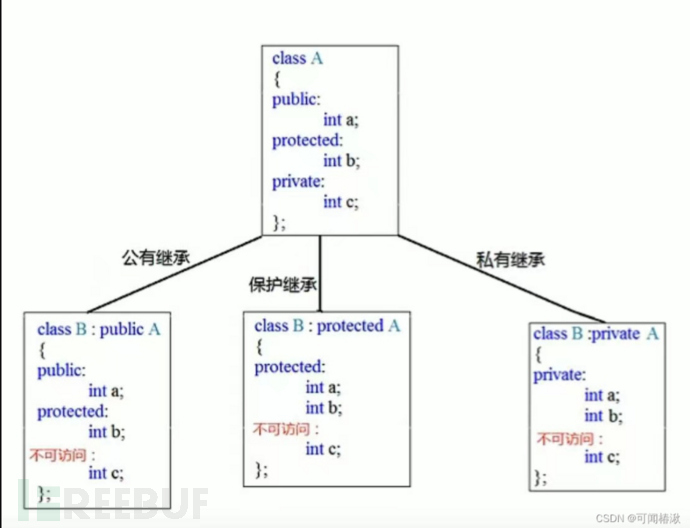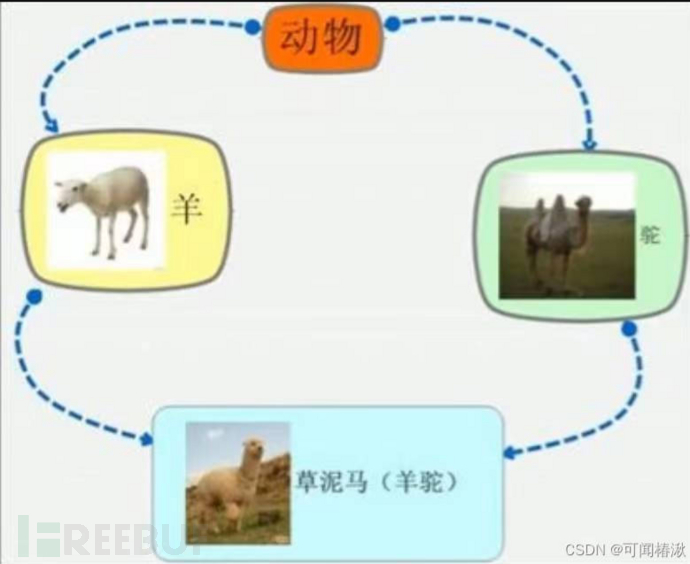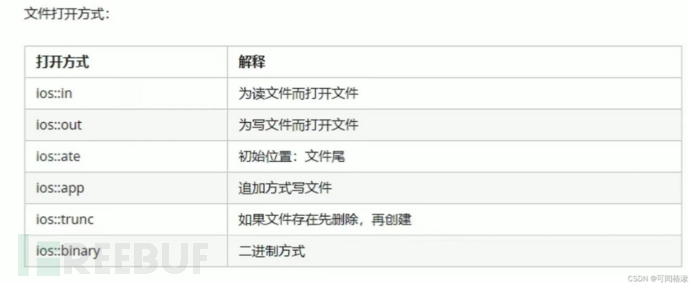类和对象-静态成员
#include <iostream>
using namespace std;
class Person {
public:
//静态成员函数
static void func() {
m_A = 100;//静态成员函数可以访问 静态成员变量
//m_B = 200;//静态成员函数不可以访问 非静态成员变量,无法区分是哪一个对象的
cout << "static func调用" << endl;
}
static int m_A;//静态
int m_B;//非静态
//静态成员函数也是有访问权限的
private:
static void func2() {
cout << "ststic void func2调用" << endl;
}
};
int Person::m_A = 0;
void test01() {
//通过对象访问
Person p;
//通过类访问
p.func();
Person::func();
//Person::func2();类外访问不到私有静态成员函数
};
int main() {
test01();
return 0;
}
类和对象-对象特征-成员变量和成员函数分开存储
#include <iostream>
using namespace std;
class Person {
public:
int m_a;//非静态成员变量,属于类的对象上
static int m_b;//静态成员变量,不属于类的对象上
void func(){}//非静态成员函数,不属于类的对象上
static void func2(){}//静态成员函数,不属于类的对象上
};
void test01() {
/*person p;
cout << "size of p=" << sizeof(p) << endl;*/
//c++编译器会给每个空对象分贝一个字节空间(为例区分空对象占的内存位置),每个空对象也应该有一个第一无二的内存地址
};
void test02() {
Person p;
cout << "size of p=" << sizeof(p) << endl;
}
int main() {
test02();
return 0;
}
类和对象-对象特征-this指针用途
每一个非静态成员函数只会诞生一份函数实例,也就是说多个同类型的对象会共用一块代码
那么问题是:这一块代码是如何区分那个对象调用自己的呢?
C++通过提供特殊的对象指针,this指针,解决上述问题。this指针指向被调用的成员函数所属的对象
his指针是隐含每一个非静态成员函数内的一种指针
this指针不需要定义,直接使用即可
this指针的用途:
1.当形参和成员变量同名时,可用this指针来区分
2.在类的非静态成员函数中返回对象本身,可使用return *this
#include <iostream>
using namespace std;
//解决名字冲突
//返回对象本身用*this
class Person {
public:
Person(int age) {
this->age = age;//this指针指向 被调用函数 所属的对象
}
Person& Personage(Person& p) {
this->age += p.age;
//this指向p2的指针,而*this指向的就是p2这个对象本体
return *this;
}
int age;
};
void test01() {
Person p1(18);
cout << "p1的年龄为:" << p1.age << endl;
}
void test02() {
Person p1(10);
Person p2(10);
//p2.Personage(p1);
p2.Personage(p1).Personage(p1).Personage(p1);//链式编程思想
cout << "p2的年龄为:" << p2.age << endl;
}
int main() {
//est01();
test02();
system("pause");
return 0;
}
类和对象-对象特征-空指针访问成员函数
c++中空指针也是可以调用成员函数的,但也要注意有没有用到this指针。
如果用到this指针,需要加以判断保证代码的健壮性。
#include <iostream>
using namespace std;
//空指针调用成员函数
class Person {
public:
void showclassname() {
cout << "this is person class" << endl;
}
void showpersonage() {
//不加if的报错原因是因为传入的指针为NULL
if (this == NULL) {
return;
}
cout << "age=" << m_Age << endl;
}
int m_Age;
};
void test01() {
Person* p = NULL;
p->showclassname();
p->showpersonage();
}
void test02() {
}
int main() {
test01();
test02();
system("pause");
return 0;
}
类和对象-对象特征-const修饰成员函数
常函数:
成员函数后加const后我们称为这个函数为常函数
常函数内不可以修改成员属性
成员属性声明时加关键字mutable后,在常函数中依然可以修改
常对象:
声明对象前加const称该对象为常对象
常对象只能调用常函数
#include <iostream>
using namespace std;
//常函数
class Person {
public:
//this指针的本质 是指针常量 指针的指向是不可以被修改的
void showPerson()const//等于const Person*const this 指针指向的值无法修改
{
this->m_B = 100;
//m_A = 100;
//this=NULL;//this指针不可以修改指针的指向
}
void func()
{
}
int m_A;
mutable int m_B;//特殊的变量,即使在常函数中,也可以修改这个值
};
void test01() {
Person p;
p.showPerson();
cout << "m_B:" << p.m_B << endl;
}
//常对象
void test02() {
const Person p;//在对象前加const,变为常对象
//p.m_A = 100;无法修改
p.m_B = 100;//m_B是特殊值,在常对象下也可以修改
//常对象只能调用常函数
//p.func();无法调用//常对象 不可以地哦啊哦那个普通成员函数,因为普通成员函数可以修改属性
}
int main() {
test01();
test02();
system("pause");
return 0;
}
类和对象-对象特征-深拷贝与浅拷贝
深浅拷贝是面试经典问题,也是常见的一个坑
浅拷贝:简单的赋值拷贝操作
深拷贝:在堆区重新申请空间,进行拷贝操作
#include <iostream>
using namespace std;
class person{
public:
person() {
cout << "默认构造函数" << endl;
}
person(int age,int high) {
m_age = age;
m_High = new int(high);
cout << "有参构造函数" << endl;
}
person(const person& p) {
cout << "拷贝构造函数" << endl;
m_age = p.m_age;
m_High = new int(*p.m_High);//若不申请新空间则会重复析构的delete
}
~person(){
if (m_High != NULL) {
delete m_High;
m_High = NULL;
}
cout << "析构函数调用" << endl;
}
int m_age;
int* m_High;
};
void test01() {
person p1(18,160);
cout << "p1的年龄为:" << p1.m_age << "身高为:" << *p1.m_High << endl;
person p2(p1);
cout << "p1的年龄为:" << p2.m_age << "身高为:" << *p2.m_High << endl;
}
int main() {
test01();
system("pause");
return 0;
}
类和对象-c++运算符重载
1.加号运算符
作用:实现两个自定义数据类型相加的运算。
#include <iostream>
using namespace std;
//加号运算符重载
class Person{
public:
//1.成员函数重载+号
/*Person operator +(Person &p) {
Person temp;
temp.m_A = this->m_A + p.m_A;
temp.m_B = this->m_B + p.m_B;
return temp;
}*/
int m_A;
int m_B;
};
//2.全局函数重载+号
Person operator+(Person& p1, Person& p2) {
Person temp;
temp.m_A = p1.m_A + p2.m_A;
temp.m_B = p1.m_B + p2.m_B;
return temp;
}
void test01() {
Person p1;
p1.m_A = 10;
p1.m_B = 10;
Person p2;
p2.m_A = 10;
p2.m_B = 10;
//成员函数重载的本质调用
//Person p3=p1.operator(p2);
//全局函数重载的本质调用
//Person p3=operator(p1,p2);
Person p3 = p1 + p2;
cout << "p3.m_A=" << p3.m_A << endl;
cout << "p3.m_B=" << p3.m_B << endl;
}
int main() {
test01();
system("pause");
return 0;
}
2.左移运算符重载
作用:可以输出自义定数据类型
#include <iostream>
using namespace std;
//左移运算符重载
class Person{
friend ostream& operator << (ostream& cout, Person& p);
public:
Person(int a,int b):m_A(a),m_B(b){}
private:
//不能利用成员函数重载 左移运算符
/*void operator<<() {
}*/
int m_A;
int m_B;
};
//利用全局函数重载左移运算符
ostream & operator << (ostream &cout,Person &p) //本质 operator<<(cout,p) 简化cout<<p
{
cout << "m_A=" << p.m_A << "m_B=" << p.m_B ;
return cout;
}
void test01() {
Person p(10,10);
cout << p <<endl;
}
int main() {
test01();
system("pause");
return 0;
}
3.递增运算符的重载
#include <iostream>
using namespace std;
//重载递增运算符
//自义定类型
class Myinteger {
friend ostream& operator<<(ostream& cout, Myinteger myint);
public:
Myinteger() {
m_Num = 0;
}
//重载前置++运算符
Myinteger& operator++()///不能去掉operator前的&
{
m_Num++;
//再将自身做返回
return *this;
}
//重载后置++运算符
Myinteger operator++(int)//int代表占位参数, 可以用于区分前置和后置
{
//先记录当前结果
Myinteger temp = *this;
//后递增
m_Num++;
//最后将记录结果做返回
return temp;
}
private:
int m_Num;
};
//重载左移运算符
ostream& operator<<(ostream& cout, Myinteger myint) {
cout << myint.m_Num;
return cout;
}
void test01() {
Myinteger myint;
cout<<++(++myint)<<endl;
cout << myint << endl;
}
void test02() {
Myinteger myint;
cout << myint++ << endl;
cout << myint << endl;
}
int main() {
test01();
test02();
system("pause");
return 0;
}
4.赋值运算符
C++编译器至少给一个类添加4个函数
1.默认构造函数(无参,函数体为空)
2.默认析构函数(无参,函数体为空)
3.默认拷贝构造函数,对属性进行值拷贝
4.赋值运算符operator=,对属性进行值拷贝
如果类中有属性指向堆区,做赋值操作时也会出现深浅拷贝问题
#include <iostream>
#include <string>
using namespace std;
//赋值运算符的重载
class Person {
public:
Person(int age) {
m_Age=new int(age);
}
~Person() {
if (m_Age != NULL) {
delete m_Age;
m_Age = NULL;
}
}
//重载赋值运算符
Person &operator=(Person& p) {
//编译器提供的是浅拷贝
//m.Age=p.m_Age;
//应该判断是否有属性在堆区,如果有先释放干净,然后再深拷贝
if (m_Age != NULL) {
delete m_Age;
m_Age = NULL;
}
//深拷贝
m_Age = new int(*p.m_Age);
//返回对象本身
return *this;
}
int* m_Age;
};
void test01() {
Person p1(18);
Person p2(20);
Person p3(30);
p3=p2 = p1;//赋值操作
cout << "p1的年龄=" << *p1.m_Age << endl;
cout << "p2的年龄=" << *p2.m_Age << endl;
cout << "p3的年龄=" << *p3.m_Age << endl;
}
int main() {
test01();
system("pause");
return 0;
}
5.关系运算符重载
作用:重载关系运算符,可以让两个自定义类型对象进行对比操作。
#include <iostream>
#include <string>
using namespace std;
//重载关系运算符
class Person {
public:
Person(string name,int age):m_Name(name), m_Age(age){}
//重载==号
bool operator==(Person& p)
{
if (this->m_Name == p.m_Name && this->m_Age == p.m_Age) {
return 1;
}
else
return 0;
}
string m_Name;
int m_Age;
};
void test01() {
Person p1("TOM", 18);
Person p2("Jerry", 18);
if (p1 == p2) {
cout << "p1和p2是相等的" << endl;
}
else
{
cout << "p1和p2是不相等的" << endl;
}
}
int main() {
test01();
system("pause");
return 0;
}
6.函数调用运算符重载
1.函数调用运算符()也可以重载
2.由于重载后使用的方式非常像函数的调用,因此称为仿函数
3.仿函数没有固定写法,非常灵活
#include <iostream>
#include <string>
using namespace std;
//函数调用运算符重载
//打印输出类
class MyPrint {
public:
//重载函数调用运算符
void operator()(string test) {
cout << test << endl;
}
};
void MyPrint02(string test){
cout << test << endl;
}
void test01() {
MyPrint myprint;
myprint("hello word");//由于使用起来非常类似于函数调用,因此称为仿函数
MyPrint02("hello word");
}
//仿函数非常灵活,没有固定的写法
//加法类
class Myadd {
public:
int operator()(int num1,int num2) {
return num1 + num2;
}
};
void test02() {
Myadd add;
int ret=add(100,100);
cout << "ret=" << ret << endl;
//匿名函数对象
cout << Myadd()(100, 100) << endl;
}
int main() {
test01();
test02();
system("pause");
return 0;
}
类和对象-继承-基本语法
例如我们看到很多网站中,都有公共的头部,公共的底部,甚至公共的左侧列表,只有中心内容不同
接下来我们分别利用普通写法和继承的写法来实现网页中的内容,看一下继承存在的意义以及好处
#include <stdio.h>
#include <iostream>
using namespace std;
//普通实现页面
//Java页面
class Java {
public:
void header() {
cout << "首页,公开课,登陆等" << endl;
}
void footer() {
cout << "帮助中心,交流合作等" << endl;
}
void left() {
cout << "Java,Python,C++等" << endl;
}
void content() {
cout << "Java学习视频" << endl;
}
};
//Python
class Python {
public:
void header() {
cout << "首页,公开课,登陆等" << endl;
}
void footer() {
cout << "帮助中心,交流合作等" << endl;
}
void left() {
cout << "Java,Python,C++等" << endl;
}
void content() {
cout << "Python学习视频" << endl;
}
};
//C++
class Cpp {
public:
void header() {
cout << "首页,公开课,登陆等" << endl;
}
void footer() {
cout << "帮助中心,交流合作等" << endl;
}
void left() {
cout << "java,python,c++等" << endl;
}
void content() {
cout << "c++学习视频" << endl;
}
};
void test01() {
cout << "-------------------" << endl;
cout << "Java下载视频页面如下: " << endl;
Java a;
a.header();
a.footer();
a.left();
a.content();
cout << "-------------------" << endl;
cout << "Python下载视频页面如下: " << endl;
Python p;
p.header();
p.footer();
p.left();
p.content();
cout << "-------------------" << endl;
cout << "C++下载视频页面如下: " << endl;
Cpp c;
c.header();
c.footer();
c.left();
c.content();
}
int main() {
test01();
return 0;
}
使用继承后:
#include <stdio.h>
#include <iostream>
using namespace std;
//继承实现页面
//继承的好处:减少重复代码
// 语法:class子类 :继承方式 父类
// 子类 也称为 派生类
// 父类 也称为 基类
//公共实现页面
class BasePage {
public:
void header() {
cout << "首页,公开课,登陆等" << endl;
}
void footer() {
cout << "帮助中心,交流合作等" << endl;
}
void left() {
cout << "Java,Python,C++等" << endl;
}
void content() {
cout << "Java学习视频" << endl;
}
};
//Java页面
class Java :public BasePage {
public:
void content() {
cout << "Java学科视频" << endl;
}
};
//Python
class Python :public BasePage {
public:
void content() {
cout << "Python学科视频" << endl;
}
};
//Cpp
class Cpp :public BasePage {
public:
void content() {
cout << "C++学科视频" << endl;
}
};
void test01() {
cout << "-------------------" << endl;
cout << "Java下载视频页面如下: " << endl;
Java a;
a.header();
a.footer();
a.left();
a.content();
cout << "-------------------" << endl;
cout << "Python下载视频页面如下: " << endl;
Python p;
p.header();
p.footer();
p.left();
p.content();
cout << "-------------------" << endl;
cout << "C++下载视频页面如下: " << endl;
Python c;
c.header();
c.footer();
c.left();
c.content();
}
int main() {
test01();
return 0;
}
总结:
继承的好处:可以减少重复的代码
class A: public B;
A类称为子类 或派生类
B类称为父类 或基类
派生类中的成员,包含两大部分:
一类是从基类继承过来的,一类是自己增加的成员。
从基类继承过过来的表现其共性,而新增的成员体现了其个性。
类和对象-继承-继承方式
继承语法:class子类:继承方式 父类
继承方式一共有三种:
1.公共继承
2.保护继承
3.私有继承

#include <stdio.h>
#include <iostream>
using namespace std;
//继承方式
//公共继承
class Base1 {
public:
int m_A;
protected:
int m_B;
private:
int m_C;
};
class Son1 :public Base1 {
public:
void func() {
int m_A = 10;//父类的公共权限成员 到子类中依然是公共权限
int m_B = 10;//父类的保护权限成员 到子类中依然是保护权限
//int m_C=10;//父类的私有权限成员 子类访问不到
}
};
void test01() {
Son1 s1;
s1.m_A = 100;
//s1.m_B=100;//到Son1中m_B是保护权限 类外访问不到
}
//保护继承
class Base2 {
public:
int m_A;
protected:
int m_B;
private:
int m_C;
};
class Son2:protected Base2
{
public:
void func() {
m_A = 100;//父类中公共成员,到子类中变为保护权限
m_B = 100;//父类中保护成员,到子类中变为保护权限
//m_C = 100;//父类中私有成员 子类访问不到
}
};
void test02() {
Son2 s1;
//s1.m_A=1000;//在Son2中m_A变为保护权限,因此类外访问不到
//s1.m_B=1000;//在Son2中m_B保护权限,不可以访问
}
//私有继承
class Base3 {
public:
int m_A;
protected:
int m_B;
private:
int m_C;
};
class Son3 :private Base3 {
public:
void func() {
m_A = 100;//父类中公共成员 到子类中变为 私有成员
m_B = 100;//父类中保护成员 到子类中变为 私有成员
//m_C = 100;//父类中私有成员,子类访问不到
}
};
class GrandSon3 :public Son3 {
public:
void func() {
//m_A = 1000;//到了Son3中 m_A变为私有,即使是孙子,也是访问不到的
//m_B = 1000;//到了Son3中 m_A变为私有,即使是孙子,也是访问不到的
}
};
void test03() {
Son3 s1;
//s1.m_A = 1000;//到Son3中 变为 私有成员 类外访问不到
//s1.m_B = 1000;//到Son3中 变为 私有成员 类外访问不到
}
int main() {
test01();
return 0;
}
类和对象-继承-继承中的对象模型
问题:从父类继承过来的成员,那些属于子类对象中
#include <stdio.h>
#include <iostream>
using namespace std;
//继承中的对象模型
class Base {
public:
int m_A;
protected:
int m_B;
private:
int m_C;
};
class Son :public Base {
public:
int m_D;
};
void test01() {
//父类中所以非静态成员数学都会被子类继承下去
//父类中私有成员属性 是被编译器给隐藏了,因此是访问不到,但是确实被继承下去了
cout << "size of Son=" << sizeof(Son) << endl;
}
int main() {
test01();
return 0;
}
类和对象-继承-构造析构顺序
子类继承父类后,当创建子类对象,也会调用父类的析构函数
问题:父类和子类的构造和析构顺序是谁先谁后?
#include <stdio.h>
#include <iostream>
using namespace std;
//继承中的构造和析构顺序
class Base {
public:
Base() {
cout << "Base的构造函数" << endl;
}
~Base() {
cout << "Base析构函数"<<endl;
}
};
class Son :public Base {
public:
Son() {
cout << "Son的构造函数" << endl;
}
~Son() {
cout << "Son析构函数" << endl;
}
};
void test01() {
//Base b;
//继承中的构造和析构顺序如下:
//先构造父类,再构造子类,析构的顺序与构造的顺序相反
Son s;
}
int main() {
test01();
return 0;
}
总结:继承中先调用父类构造函数,再调用子类构造函数,析构顺序与构造相反(先调用子类析构函数再调用父类析构函数)
类和对象-继承-同名成员处理
问题:当子类与仪类出现同名的成员,如何通过子类对象,访问到子类或父类中同名的数据呢?
访问子类同名成员 ,直接访问即可
访问父类同名成员,需要加作用域
#include <stdio.h>
#include <iostream>
using namespace std;
//继承中同名成员处理
class Base {
public:
Base() {
m_A = 100;
}
int m_A;
void func() {
cout << "Base下的func调用" << endl;
}
void func(int a) {
cout << "Base下的func(int a)调用" << endl;
}
};
class Son :public Base {
public:
Son() {
m_A = 200;
}
int m_A;
void func() {
cout << "Son下的func调用" << endl;
}
};
//同名的成员属性处理
void test01() {
Son s;
cout << "Son 下的m_A=" << s.m_A << endl;
//如果通过子类对象 访问到父类中同名成员,需要加作用域
cout << "Base 下的m_A=" << s.Base::m_A << endl;
}
//同名的成员函数处理
void test02() {
Son s;
s.func();
s.Base::func();
//如果子类中出现和父类同名的成员函数,子类同名成员会隐藏掉父类中所有同名成员函数
//如果想访问到父类中被隐藏的同名成员函数,需要加作用域
s.Base::func(100);
}
int main() {
test01();
test02();
return 0;
}
总结:
1.子类对象可以直接访问到子类中同名成员
2.子类对象加作用域可以访问到父类同名成员
3.当子类与父类拥有同名的成员函数,子类会隐藏父类中同名成员函数,加作用域可以访问到父类中同名函数
类和对象-继承-同名静态成员处理
问题:继承中同名的静态成员在子类对象上如何进行访问?
静态成员和非静态成员出现同名,处理方式一致
访问子类同名成员 直接访问即可
访问父类同名成员 需要加作用域
#include <stdio.h>
#include <iostream>
using namespace std;
//继承中的同名静态成员处理方式
class Base {
public:
static int m_A;
static void func() {
cout << "Base下static void func的函数调用" << endl;
}
};
int Base::m_A = 100;
class Son:public Base {
public:
static int m_A;
static void func() {
cout << "Son下static void func的函数调用" << endl;
}
};
int Son::m_A = 200;
//同名静态成员属性
void test01() {
//1.通过对象来访问
Son s;
cout << "m_A=" << s.m_A << endl;
cout << "m_A=" << s.Base::m_A << endl;
//2.通过类名来访问
cout << "通过类名来访问" << endl;
cout << "Son下m_A=" << Son::m_A << endl;
//第一个::代表通过类名的方式来访问 第二个::代表访问父类作用域下
cout << "Base下m_A=" << Son::Base::m_A << endl;
}
//同名静态成员函数
void test02() {
//通过对象访问
cout << "通过对象访问" << endl;
Son s;
s.func();
s.Base::func();
//通过类名访问
cout << "通过类名来访问" << endl;
Son::func();
Son::Base::func();
}
int main() {
test01();
test02();
return 0;
}
总结:同名静态成员处理方式和非静态处理方式一样,只不过有两种访问的方式(通过对象 和 通过类名)
类和对象-继承-继承语法
C++允许一个类继承多个类
语法:class子类:继承方式 父类1 ,继承方式 父类2...
多继承可能会引发父类中有同名成员出现,需要加作用域区分
C++实际开发中不建议用多继承
#include <stdio.h>
#include <iostream>
using namespace std;
//多继承语法
class Base1 {
public:
Base1() {
m_A = 100;
}
int m_A;
};
class Base2 {
public:
Base2() {
m_A = 200;
}
int m_A;
};
//子类 需要继承Base1和Base2
//语法:class子类:继承方式 父类1,继承方式 父类2..
class Son :public Base1, public Base2 {
public:
Son()
{
m_C = 300;
m_D = 400;
};
int m_C;
int m_D;
};
void test01() {
Son s;
cout << "sizeof Son=" << sizeof(s) << endl;
//当父类中出现同名成员,需要加作用于区分
cout << "Base1 m_A=" << s.Base1::m_A << endl;
cout << "Base2 m_A=" << s.Base2::m_A << endl;
}
int main() {
test01();
return 0;
}
总结:多继承中如果父类中出现了同名情况,子类使用时要加作用域。
类和对象-继承-菱形继承问题以及解决方案
菱形继承概念:
两个派生类继承同一个基类
又有某个类同时继承者两个派生类
这种继承被称为菱形继承,或者钻石继承
典型的菱形继承案例:

菱形继承问题:
1.羊继承了动物的数据,驼同样继承了动物的数据,当草泥马使用数据时,就会产生二义性。
2.草泥马继承自动物的数据继承了两份,其实我们应该清楚,这份数据我们只需要一份就可以。
#include <stdio.h>
#include <iostream>
using namespace std;
//动物类
class Animal {
public:
int m_A;
};
//利用虚继承 可以解决菱形继承问题
//在继承之前加上 关键字 virtual 变为虚继承
// Animal类称为 虚基类
//羊类
class Sheep:virtual public Animal{};
//驼类
class Tuo :virtual public Animal {};
//羊驼类
class Sheeptuo:public Sheep,public Tuo{};
void test01() {
Sheeptuo st;
st.Sheep::m_A = 18;
st.Tuo::m_A = 28;
//当菱形继承,两个父类具有相同的数据,需要加以作用域区分。
cout << "st.Sheep::m_A =" << st.Sheep::m_A << endl;
cout << "st.Tuo::m_A = " << st.Tuo::m_A << endl;
cout << "st,m_A=" << st.m_A << endl;
//这份数据我们知道 只要有一份即可,菱形继承导致数据有两份,资源浪费。
}
int main() {
test01();
return 0;
}
总结:
菱形继承带来的主要问题是子类继承两份相同的数据,导致资源浪费以及毫无意义
利用虚继承可以解决菱形继承问题
类和对象-多态-多态的基本语法
多态是C++面向对象三大特性之一
多态分为两类
1.静态多态:函数重载和近算符重载属于静态多态,复用函数名
2.动态多态:派生类和虚函数实现运行时多态
静态多态和动态多态区别:
1.静态多态的函数地址早绑定-编译阶段确定函数地址
2.动态多态的函数地址晚绑定-运行阶段确定函数地址
下面通过案例进行讲解多态:
#include <stdio.h>
#include <iostream>
using namespace std;
//多态
//动物类
class Animal {
public:
//虚函数
virtual void speak() {
cout << "动物在说话" << endl;
}
};
//猫类
class Cat:public Animal{
public:
//重写 函数返回值类型 函数名 参数列表 完全相同
void speak() {
cout << "小猫在说话" << endl;
}
};
//狗类
class Dog :public Animal {
public:
void speak() {
cout << "小狗在说话" << endl;
}
};
//执行说话的函数
//地址早绑定 在编译阶段确定函数地址
//如果想执行让猫说话,那么这个函数就不能提前绑定,需要在运行阶段进行绑定,地址晚绑定
//动态多态满足条件
//1.有继承关系
//2.子类要重写父类虚函数
//动态多态使用
//父类的指针或者引用 执行子类对象
void dospeak(Animal &animal)//Animal & animal=cat;
{
animal.speak();
}
void test01() {
Cat cat;
dospeak(cat);
Dog dog;
dospeak(dog);
Animal animal;
dospeak(animal);
}
int main() {
test01();
return 0;
}
类和对象-多态-案例1-计算器类
案例描述:
分别利用普通写法和多态技术,设计实现两个操作数进行运算的计算器类
多态的优点:
1.代码组织结构清晰
2.可读性强
3.利于前期和后期的扩展以及维护
#include <stdio.h>
#include <iostream>
#include<string>
using namespace std;
//分别利用普通写法和多态技术实现计算器类
//普通写法
class Calculator {
public:
int getResult(string oper) {
if (oper == "+") {
return m_Num1 + m_Num2;
}
else if (oper == "-") {
return m_Num1 - m_Num2;
}
else if (oper == "*") {
return m_Num1 * m_Num2;
}
//如果要扩展新的功能,需要修改源码
//在真实的开发中 提倡 开闭原则
//开闭原则:对扩展进行开放,对修改进行关闭
}
int m_Num1;
int m_Num2;
};
void test01() {
//创建计算器对象
Calculator c;
c.m_Num1 = 10;
c.m_Num2 = 20;
cout << c.m_Num1 << "+" << c.m_Num2 << "=" << c.getResult("+") << endl;
cout << c.m_Num1 << "-" << c.m_Num2 << "=" << c.getResult("-") << endl;
cout << c.m_Num1 << "*" << c.m_Num2 << "=" << c.getResult("*") << endl;
}
//利用多态实现计算器
//多态好处:
// 1.组织结构清晰
// 2.可读性强
// 3.对于前期和后期扩展以及维护性高
//实现计算器的抽象类
class AbstractCalculator {
public:
virtual int getResult() {
return 0;
}
int m_Num1;
int m_Num2;
};
//加法计算器类
class AddCalculator :public AbstractCalculator {
public:
int getResult() {
return m_Num1 + m_Num1;
}
};
//减法计算器类
class SubCalculator :public AbstractCalculator {
public:
int getResult() {
return m_Num1 - m_Num1;
}
};
//乘法计算器类
class MulCalculator :public AbstractCalculator {
public:
int getResult() {
return m_Num1 * m_Num1;
}
};
void test02() {
//多态使用条件
//父类指针或者引用指向子类对象
//加法运算
AbstractCalculator* abc = new AddCalculator;
abc->m_Num1 = 100;
abc->m_Num2 = 100;
cout << abc->m_Num1 << "+" << abc->m_Num2 << "=" << abc->getResult() << endl;
//用完后记得销毁
delete abc;
//减法运算
abc = new SubCalculator;
abc->m_Num1 = 100;
abc->m_Num2 = 100;
cout << abc->m_Num1 << "-" << abc->m_Num2 << "=" << abc->getResult() << endl;
delete abc;
//乘法运算
abc = new MulCalculator;
abc->m_Num1 = 100;
abc->m_Num2 = 100;
cout << abc->m_Num1 << "*" << abc->m_Num2 << "=" << abc->getResult() << endl;
delete abc;
}
int main(){
//test01();
test02();
system("Pause");
return 0;
}
总结:C++开发提倡利用多态设计程序架构,因为多态优点很多
类和对象-多态- 纯虚函数和抽象类
在多态中,通常父类中虚函数的实现是毫无意义的,主要都是调用子类重写的内容
因此可以将虚函数改为纯虚函数
纯虚函数语法:
virtual 返回值类型 函数名 (参数列表)=0;
当类中有了纯虚函数,这个类也称为抽象类
抽象类特点:
1.无法实例化对象
2.子类必须重写抽象类中的纯虚函数,否则也属于抽象类
#include <stdio.h>
#include <iostream>
#include<string>
using namespace std;
//纯虚函数和抽象类
class Base
{
public:
//纯虚函数
//只要有一个纯虚函数,这个类称为抽象类
//抽象类的特点:
//1.无法实例化对象
//2.抽象类的子类 必须要 =重写父类中的纯虚函数,否则也属于抽象类
virtual void func() = 0;
};
class Son :public Base {
public:
virtual void func() {
cout << "func函数调用" << endl;
}
};
void test01() {
//Base b;//抽象类无法实例化对象
//new Base;//抽象类无法实例化对象
//Son s;//子类中必须重写父类中的纯虚函数,否则无法实例化对象
Base* base = new Son;
base->func();
}
int main() {
test01();
system("pause");
return 0;
}
类和对象-多态-案例2-制作饮品
案例描述:
制作饮品的大致流程为:煮水-冲泡-倒入杯中-加入辅料
利用多态技术实现本案例,提供抽象制作饮品基类,提供子类制作咖啡和茶叶
#include <stdio.h>
#include <iostream>
#include<string>
using namespace std;
//多态的案例2 制作饮品
class Abstractdrinking
{
public:
//煮水
virtual void Boil() = 0;
//冲泡
virtual void Brew() = 0;
//导入杯中
virtual void Pourincup() = 0;
//加入辅料
virtual void Putsomething() = 0;
//制作饮品
void makedrink() {
Boil();
Brew();
Pourincup();
Putsomething();
}
};
class coffee :public Abstractdrinking {
//煮水
virtual void Boil() {
cout << "煮农夫山泉" << endl;
}
//冲泡
virtual void Brew() {
cout << "冲泡咖啡" << endl;
}
//导入杯中
virtual void Pourincup() {
cout << "导入杯中" << endl;
}
//加入辅料
virtual void Putsomething(){
cout << "加入糖和牛奶" << endl;
}
};
class tea:public Abstractdrinking {
//煮水
virtual void Boil() {
cout << "煮矿泉水" << endl;
}
//冲泡
virtual void Brew() {
cout << "冲泡茶叶" << endl;
}
//导入杯中
virtual void Pourincup() {
cout << "导入杯中" << endl;
}
//加入辅料
virtual void Putsomething() {
cout << "加入柠檬" << endl;
}
};
void dowork(Abstractdrinking *abs) //Abstractdrinking *abs=new coffee
{
abs->makedrink();
delete abs;//释放
}
void test01() {
dowork(new coffee);
cout << "------------" << endl;
dowork(new tea);
}
int main() {
test01();
system("pause");
return 0;
}
类和对象-多态-虚析构和纯虚析构
多态使用时,如果子类中有属性开辟到堆区,那么父类指针在释放时无法调用到子类的析构代码
解决方式:将父类中的析构函数改为虚析构或者纯虚析构
虚析构和纯虚析构共性:
·可以解决父类指针释放子类对象
·都需要有具体的函数实现
虚析构和纯虚析构区别:
·如果是纯虚析构,该类属于抽象类,无法实例化对象
虚析构语法:
virtual ~类名(){]
纯虚析构语法:
virtual ~类名()= 0;
类名: :~类名(){]
#include <stdio.h>
#include <iostream>
#include<string>
using namespace std;
//虚析构和纯虚析构
class Animal {
public:
Animal() {
cout << "Animal构造函数调用" << endl;
}
//利用虚析构可以解决 父类指针释放子类对象时不干净的问题
/*virtual ~animal()
{
cout << "Animal析构函数调用" << endl;
}*/
//纯虚析构 需要声明也需要实现
//有了纯虚析构 之后,这个类也属于抽象类,无法实例化对象
virtual ~Animal() = 0;
//纯虚函数
virtual void speak() = 0;
};
Animal:: ~Animal() {
cout << "Animal的纯虚析构析构函数调用" << endl;
}
class Cat :public Animal {
public:
Cat(string name) {
cout << "Cat构造函数调用" << endl;
m_Name=new string(name);
}
virtual void speak() {
cout << *m_Name<<"小猫在说话" << endl;
}
~Cat()
{
if (m_Name != NULL) {
cout <<"Cat析构函数调用" << endl;
delete m_Name;
m_Name = NULL;
}
}
string* m_Name;
};
void test01() {
Animal* animal = new Cat("Tom");
animal->speak();
//父类指针在析构时候, 不会调用子类中析构函数,导致子类如果有堆区属性,出现内存泄漏
delete animal;
}
int main() {
test01();
system("pause");
return 0;
}
总结:
1.虚析构或纯虚析构就是用来解决通过父类指针释放子类对象
2.如果子类中没有堆区数据,可以不写为虚析构或纯虚析构
3.拥有纯虚析构函数的类也属于抽象类
类和对象-多态-案例3-电脑组转需求分析
电脑主要组成部件为CPU(用于计算),显卡(用于显示),内存条(用于存储)
将每个零件封装出抽象基类,并且提供不同的厂商生产不同的零件,例如Intel厂商和Lenovo厂商
创建电脑类提供让电脑工作的函数,并且调用每个零件工作的接口
测试时组装三台不同的电脑进行工作
#include <stdio.h>
#include <iostream>
#include<string>
using namespace std;
//抽象不同零件类
//抽象CPU类
class CPU{
public:
//抽象的计算函数
virtual void calculate() = 0;
};
//抽象显卡类
class VideoCard {
public:
//抽象的显示函数
virtual void display() = 0;
};
//抽象内存条类
class Memory{
public:
//抽象的储存函数
virtual void storage() = 0;
};
//电脑类
class Computer {
public:
Computer(CPU* cpu, VideoCard* vc, Memory* mem) {
m_cpu = cpu;
m_vc = vc;
m_mem = mem;
}
//提供工作函数
void work() {
//让零件工作起来,调用接口
m_cpu->calculate();
m_vc->display();
m_mem->storage();
}
//提供一个析构函数 释放三个电脑零件
~Computer()
{
//释放CPU零件
if (m_cpu != NULL) {
delete m_cpu;
m_cpu = NULL;
}
//释放显卡零件
if (m_vc != NULL) {
delete m_vc;
m_vc = NULL;
}
//释放内存条零件
if (m_mem != NULL) {
delete m_mem;
m_mem= NULL;
}
}
private:
CPU* m_cpu;//CPU的零件指针
VideoCard* m_vc;//显卡的零件指针
Memory* m_mem;//内存条的零件指针
};
//具体厂商
//Intal厂商
class IntelCPU:public CPU {
public:
virtual void calculate() {
cout << "Intel的CPU开始计算了" << endl;
}
};
class IntelVideoCard :public VideoCard {
public:
virtual void display() {
cout << "Intel的显卡开始显示了" << endl;
}
};
class IntelMemory :public Memory {
public:
virtual void storage() {
cout << "Intel的内存条开始显示了" << endl;
}
};
//Lenovo厂商
class LenovoCPU :public CPU {
public:
virtual void calculate() {
cout << "Lenovo的CPU开始计算了" << endl;
}
};
class LenovoVideoCard :public VideoCard {
public:
virtual void display() {
cout << "Lenovo的显卡开始显示了" << endl;
}
};
class LenovoMemory :public Memory {
public:
virtual void storage() {
cout << "Lenovo的内存条开始显示了" << endl;
}
};
void test01() {
cout << "第一台电脑开始工作:" << endl;
//第一台电脑零件
CPU* intelCpu = new IntelCPU;
VideoCard* intelCard = new IntelVideoCard;
Memory* intelMen = new IntelMemory;
//创建第一台电脑
Computer* computer1 = new Computer(intelCpu, intelCard, intelMen);
computer1->work();
delete computer1;
cout << "-----------------" << endl;
cout << "第二台电脑开始工作:" << endl;
//第二台电脑组装
Computer* computer2= new Computer(new LenovoCPU,new LenovoVideoCard ,new LenovoMemory );
computer2->work();
delete computer2;
cout << "-----------------" << endl;
cout << "第三台电脑开始工作:" << endl;
//第二台电脑组装
Computer* computer3 = new Computer(new LenovoCPU, new IntelVideoCard, new LenovoMemory);
computer3->work();
delete computer3;
};
int main() {
test01();
system("pause");
return 0;
}
C++文件操作-文本文件-写文件
程序运行时产生的数据都属于临时数据,程序一旦运行结束都会被释放
通过文件可以将数据持久化
C++中对文件操作需要包含头文件<fstream
文件类型分为两种:
1.文本文件-文件以文本的ASCII码形式存储在计算机中
2.二进制文件-文件以文本的二进制形式存储在计算机中,用户一般不能直接读懂它们
操作文件的三大类:
1.ofstream:写操作
2. ifstream:读操作
3.fstream:读写操作
写文件:
写文件步骤如下:
1.包含头文件
#include <fstream>
2.创建流对象
ofstream ofs;
3.打开文件
ofs.open("文件路径”,打开方式);
4.写数据
ofs <<“写入的数据";
5.关闭文件
ofs.close();

#include <iostream>
#include<fstream>//头文件包含
using namespace std;
//文本文件 写文件
void test01() {
//1.包含头文件fstream
//2.创建流对象
ofstream ofs;
//3.指定打开方式
ofs.open("test.text", ios::out);
//4.写内容
ofs << "姓名:张三" << endl;
ofs << "姓别:男" << endl;
ofs << "年龄:18" << endl;
//5.关闭文件
ofs.close();
}
int main() {
test01();
system("pause");
return 0;
}
总结:
1.文件操作必须包含头文件fstream
2.读文件可以利用ofstream,或者fstream类
3.打开文件时候需要指定操作文件的路径,以及打开方式
4.利用<<可以向文件中写数据
5.操作完毕,要关闭文件
C++文件操作-文本文件-读文件
读文件与写文件步骤相似,但是读取方式相对于比较多
读文件步骤如下:
1.包含头文件
#include <fstream>
2.创建流对象
ifstream ifs;
3.打开文件并判断文件是否打开成功
ifs.open("文件路径",打开方式);
4.读数据
四种方式读取
5.关闭文件
ifs.close();
#include <iostream>
using namespace std;
#include<fstream>
#include<string>
//文本文件 读文件
void test01() {
//1.包含头文件
//2.创建流对象
ifstream ifs;
//3.打开文件 并且判断是否打开成功
ifs.open("test.txt",ios::in);
if (!ifs.is_open()) {
cout << "文件打开失败" << endl;
return;
}
//4.读数据
//第一种
/*char buf[1024] = { 0 };
while (ifs >> buf){
cout << buf << endl;
}*/
//第二种
/*char buf[1024] = { 0 };
while (ifs.getline(buf, sizeof(buf))) {
cout << buf << endl;
}*/
//第三种
/*string buf;
while (getline(ifs, buf)) {
cout << buf << endl;
}*/
//第四种
char c;
while ((c = ifs.get()) != EOF)//EOF end of file
{
cout << c;
}
//5.关闭文件
ifs.close();
}
int main() {
test01();
return 0;
}
总结:
1.读文件可以利用ifstream,或者fstream类
2.利用is_open函数可以判断文件是否打开成功
3.close 关闭文件
C++文件操作-二进制文件-写文件
以二进制的方式对文件进行读写操作
打开方式要指定为 jos:binary
写文件
二进制方式写文件主要利用流对象调用成员函数write
函数原型:
ostream& write(constchar * buffer,int len);
参数解释:字符指针buffer指向内存中一段存储空间。len是读写的字节数
#include <iostream>
using namespace std;
#include<fstream>
//二进制文件 写文件
class Person {
public:
char m_Name[64];//姓名
int m_Age;//年龄
};
void test01() {
//1.包含头文件
//2.创建流文件
ofstream ofs("Person.text", ios::out | ios::binary);
//3.打开文件
//ofs.open("Person.text", ios:: out | ios::binary);
//4.写文件
Person P = { "张三",18 };
ofs.write((const char*)&P, sizeof(Person));
//5.关闭文件
ofs.close();
}
int main() {
test01();
return 0;
}
读文件
二进制方式读文件主要利用流对象调用成员函数read
函数原型:
istream& read(char *buffer,int len);
参数解释:字符指针buffer指向内存中一段存储空间。len是读写的字节数
#include <iostream>
using namespace std;
#include<fstream>
class Person {
public:
char m_Name[64];//姓名
int m_Age;//年龄
};
//二进制文件 读文件
void test01() {
//1.包含头文件
//2.创建流对象
ifstream ifs;
//3.打开文件 判断文件是否打开成功
ifs.open("person.text", ios::in | ios::binary);
if (!ifs.is_open()) {
cout << "文件打开失败" << endl;
return;
}
//4.读文件
Person p;
ifs.read((char*)&p, sizeof(Person));
cout << "姓名:" << p.m_Name << "年龄:" << p.m_Age << endl;
//5.关闭文件
ifs.close();
}
int main() {
test01();
return 0;
}
4A评测 - 免责申明
本站提供的一切软件、教程和内容信息仅限用于学习和研究目的。
不得将上述内容用于商业或者非法用途,否则一切后果请用户自负。
本站信息来自网络,版权争议与本站无关。您必须在下载后的24个小时之内,从您的电脑或手机中彻底删除上述内容。
如果您喜欢该程序,请支持正版,购买注册,得到更好的正版服务。如有侵权请邮件与我们联系处理。敬请谅解!
程序来源网络,不确保不包含木马病毒等危险内容,请在确保安全的情况下或使用虚拟机使用。
侵权违规投诉邮箱:4ablog168#gmail.com(#换成@)


